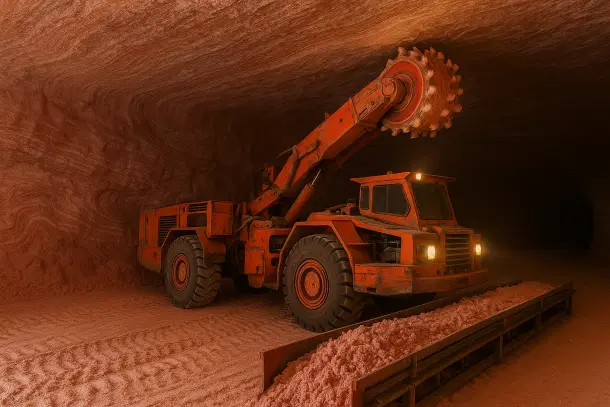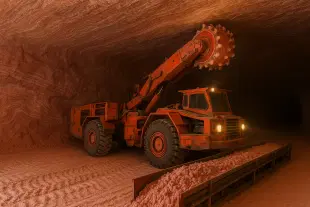News Brief
India Eyes Rare Earth Security Amid China’s Supply Curbs, Focusing On Beach Sands, Hard Rocks And Global Deals—Explained
Swarajya Staff
Jul 23, 2025, 05:34 PM | Updated 05:34 PM IST
Save & read from anywhere!
Bookmark stories for easy access on any device or the Swarajya app.


India is making significant strides in securing its future supply of rare earth elements (REE), with the Central government ramping up exploration efforts in key areas.
The government is focusing on three major avenues: beach sands, hard rock formations, and overseas mineral assets.
What Are Rare Earth Elements (REE) and Why Are They Important?
Rare earth elements (REEs) are a group of 17 chemically similar elements, including lanthanides like neodymium and dysprosium, along with scandium and yttrium.
These elements are crucial for modern technologies due to their unique magnetic, catalytic, and optical properties.
They are key components in a wide range of high-tech products, including:
Electric vehicles (EVs), where they are used in powerful magnets for motors and batteries.
Renewable energy technologies, including wind turbines, where they help generate electricity.
Defence applications, including precision-guided missiles, radar systems, and jet engines.
Consumer electronics, such as smartphones, laptops, and flat-screen TVs.
In addition to rare earth elements, lithium has emerged as one of the most critical minerals for the 21st century.
Though not technically a rare earth element, lithium is indispensable for the batteries used in electric vehicles and energy storage systems.
As the world shifts toward greener technologies, the demand for lithium has surged, making it a central focus in India’s strategy to ensure energy security and technological self-reliance.
Due to their critical uses, REEs and lithium are considered vital for achieving energy transition goals and maintaining national security.
However, the global supply of these elements is highly concentrated, with China controlling a significantly high portion of both rare earth and lithium production.
China recently imposed export restrictions on eight key electric vehicle (EV) battery technologies, including key tech used to produce battery cathodes, a crucial component in lithium-ion batteries that determines their energy density and performance.
China had earlier in April imposed tighter export controls on rare earth magnets — critical components for electric vehicles, wind turbines, and electronics.
The move resulted in a sharp drop in global shipments and rising uncertainty across supply chains.
Export approvals became slow and selective, forcing manufacturers across sectors to wait weeks for shipments or rework sourcing entirely.
India’s electric vehicle and auto parts industry was also among those hits by Chinese export curbs, with automakers reporting delays in sourcing magnets and electric motor component.
This reliance on one nation has made countries like India focus on securing a stable, diversified supply to ensure long-term technological advancement and economic resilience.
Beach Sands and Hard Rocks: India's Domestic Riches
The Atomic Minerals Directorate for Exploration and Research (AMD), under India's Department of Atomic Energy (DAE), has identified reserves of rare earths in coastal and inland regions of India, particularly in beach sands and hard rock formations.
These reserves are spread across multiple states, including Andhra Pradesh, Odisha, Tamil Nadu, Kerala, West Bengal, and Gujarat.
Around 7.23 million tonnes of in-situ Rare Earth Elements Oxide (REO) are estimated to be contained in 13.15 million tonnes of monazite—a key mineral that holds both rare earth elements and thorium.
In addition, AMD has estimated 1.29 million tonnes of REO in hard rock formations, primarily found in Gujarat and Rajasthan.
This domestic exploration is poised to meet the rising demand for REE, critical to sectors like electric vehicles, renewable energy, and defence.
Expanding Beyond Domestic Boundaries
In parallel, the Ministry of Mines is pushing for global cooperation to secure strategic mineral assets, evidenced by the Khanij Bidesh India Limited (KABIL) initiative.
This joint venture firms aims to acquire rare earth mining assets including Lithium, Cobalt, and others internationally, focusing on nations with abundant resources, including in South America, Australia, and Africa.
KABIL has already signed a major agreement with Argentina's CAMYEN to explore lithium-rich regions in Catamarca province, aiming to tap into the growing demand for electric vehicle batteries and other critical technologies.
KABIL is also having regular interactions with Critical Mineral Office in Australia with the primary objective of acquiring critical and strategic mineral assets.
Further, Ministry of Mines has initiated the process of entering into Government to Government (G2G) MoUs with Brazil and Dominican Republic for developing cooperation in the field of Rare Earth Minerals and Critical Minerals.
Key Amendments and Investments to Strengthen Domestic Exploration
To further enhance domestic exploration, the government has made key amendments to the Mines and Minerals (Development and Regulation) Act (MMDR).
These reforms, effective from August 2023, include omission of six minerals from the list of 12 atomic minerals namely Lithium, Titanium, Beryl and beryllium bearing minerals, Niobium, Tantalum and Zirconium bearing minerals.
India is also actively involved in international platforms such as the Minerals Security Partnership (MSP) and the Indo-Pacific Economic Framework (IPEF) to bolster its rare earth supply chains.
These engagements will strengthen India's global standing as a reliable player in the critical minerals market.
Further in order to develop a coordinated approach, the Union Cabinet has approved the launch of the National Critical Mineral Mission (NCMM) on 29 January 2025 with an expenditure of Rs 16,300 crore and expected investment of Rs 18,000 crore by PSUs, etc.
The mission will be implemented over a period of seven years, from FY 2024-25 to 2030- 31 with a budgetary support of Rs 2,600 crore.




